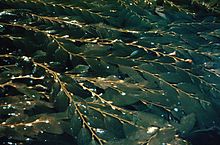
Back سفليج Arabic سفليج ARZ Macrocystis Czech Macrocystis Spanish Macrocystis French Macrocystis Italian მაკროცისტისი Georgian Macrocystis Portuguese Макроцистис Russian Макроцистіс Ukrainian
| Macrocystis | |
|---|---|

| |
| Macrocystis pyrifera | |
| Scientific classification | |
| Domain: | Eukaryota |
| Clade: | Diaphoretickes |
| Clade: | SAR |
| Clade: | Stramenopiles |
| Phylum: | Gyrista |
| Subphylum: | Ochrophytina |
| Class: | Phaeophyceae |
| Order: | Laminariales |
| Family: | Laminariaceae |
| Genus: | Macrocystis C.Agardh |
| Species: | M. pyrifera
|
| Binomial name | |
| Macrocystis pyrifera (L.) C.Agardh
| |
| Synonyms | |
Heterotypic synonymsC. Agardh[1]
| |
Macrocystis is a monospecific genus[3] of kelp (large brown algae) with all species now synonymous with Macrocystis pyrifera. It is commonly known as giant kelp or bladder kelp. This genus contains the largest of all the Phaeophyceae or brown algae. Macrocystis has pneumatocysts at the base of its blades. Sporophytes are perennial and the individual may live for up to three years;[4] stipes/fronds within a whole individual undergo senescence, where each frond may persist for approximately 100 days.[5] The genus is found widely in subtropical, temperate, and sub-Antarctic oceans of the Southern Hemisphere (e.g. Chile, New Zealand, Australia, Falkland Islands, Auckland Islands, South African west coast, etc.) and in the northeast Pacific from Baja California to Sitka, Alaska. Macrocystis is often a major component of temperate kelp forests.
Despite its appearance, it is not a plant; it is a heterokont. Giant kelp is common along the coast of the northeastern Pacific Ocean, from Baja California north to southeast Alaska, and is also found in the southern oceans near South America, South Africa, Australia, and New Zealand. Individual algae may grow to more than 45 metres (150 feet) long at a rate of as much as 60 cm (2 ft) per day. Giant kelp grows in dense stands known as kelp forests, which are home to many marine animals that depend on the algae for food or shelter. The primary commercial product obtained from giant kelp is alginate, but humans also harvest this species on a limited basis for use directly as food, as it is rich in iodine, potassium, and other minerals. It can be used in cooking in many of the ways other sea vegetables are used, and particularly serves to add flavor to bean dishes.
- ^ Guiry, M.D. & Guiry, G.M., AlgaeBase: Species: Macrocystis integrifolia, National University of Ireland, Galway. Retrieved 7 February 2013.
- ^ Bory de Saint-Vincent, J.B.G.M. (1826). Macrocyste. In: Dictionnaire Classique d'Histoire Naturelle. (Audouin, I. et al. Eds) Vol. 10, pp. 8-10. Paris:
- ^ Macaya, Erasmo C.; Zuccarello, Giuseppe C. (August 2010). "DNA barcoding and genetic divergence in the Giant Kelp Macrocystis (Laminariales)". Journal of Phycology. 46 (4): 736–742. doi:10.1111/j.1529-8817.2010.00845.x. S2CID 84033275.
- ^ W.J. North (1971) The biology of giant kelp beds.
- ^ G.E. Rodriguez, A. Rassweiler, D.C. Reed, & S.J. Holbrook (2013) The importance of progressive senescence in the biomass dynamics of giant kelp (Macrocystis pyrifera). Ecology, 94(8), 1848-1858.